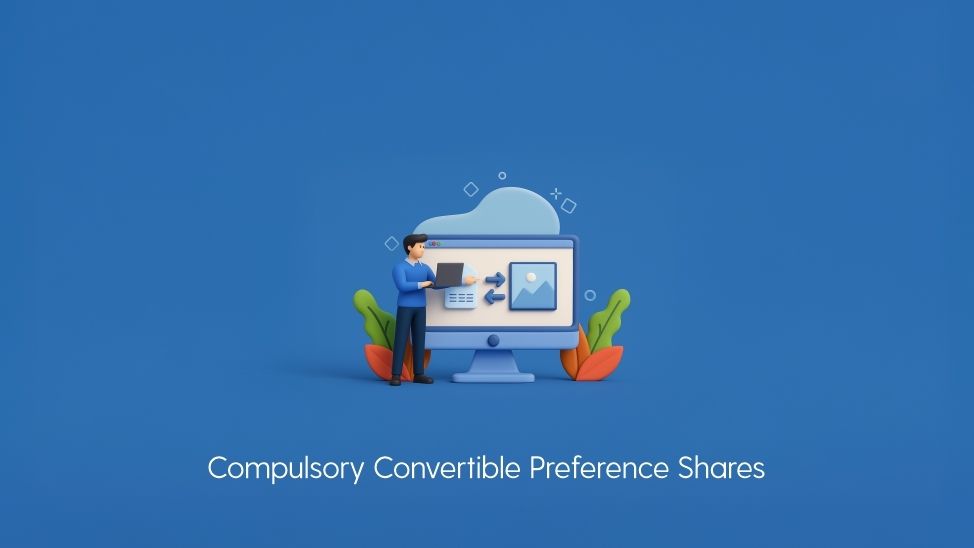- Home
- Blog
- Demat Account
- What is CCPS (Compulsory Convertible Preference Shares)?
- What is CCPS (Compulsory Convertible Preference Shares)?
What is CCPS (Compulsory Convertible Preference Shares)?

- Published Date: October 29, 2025
- Updated Date: October 29, 2025
- By Team Choice
When companies seek innovative ways to raise capital without immediately diluting ownership, Compulsory Convertible Preference Shares (CCPS) often emerge as a viable solution. But what is CCPS, and how does it differ from regular equity shares?
In this blog, we’ll break down what CCPS means, explore its key features, advantages, and risks, understand the difference between CCPS and equity shares, and discuss who should consider investing in convertible preference shares.
Before we deep dive into CCPS, let’s first break down the concept of convertible preference shares.
What are Covertible Preference Shares?
Convertible preference shares are a special class of shares that initially grant investors a fixed dividend and preferential treatment over ordinary shareholders. However, unlike regular preference shares, these can be converted into equity shares at a later date, either optionally or compulsorily, based on the terms agreed upon during issuance.
OCPS and CCPS are two main types of convertible preference shares. The OCPS stands for Optional Convertible Preference Shares, where investors have the option to choose whether to convert the shares into equity. On the other hand, CCPS’s full form is Compulsory Convertible Preference Shares, where conversion of shares into equity is mandatory after a specific period.
Now, let’s explore CCPS’s meaning in detail -
Compulsory Convertible Preference Shares: As we discussed earlier, CCPS are a special class of preference shares that automatically convert into equity shares after a predetermined period or once specific conditions are fulfilled. Unlike traditional preference shares, investors don’t have the option to retain them indefinitely; the conversion is mandatory.
CCPS functions as a hybrid financial instrument, blending the security of debt with the growth potential of equity. Investors earn a fixed dividend during the preference share phase, and later gain ownership rights when the shares convert into equity. This makes compulsory convertible preference shares an attractive financing option for companies seeking funds while maintaining management control.
Key Features of Compulsory Convertible Preference Shares
Understanding the key features of CCPS helps clarify how they work and why they’re widely used by companies and investors alike.
1. Fixed Dividend Income:
CCPS holders are entitled to a predetermined dividend rate until the shares are converted into equity. This ensures a steady and predictable income stream during the holding period, similar to interest payments on debt instruments.
2. Mandatory Conversion to Equity:
The defining characteristic of CCPS is that conversion into equity shares is compulsory. Both the conversion timing and conversion ratio are specified at the time of issuance, providing clarity to investors about when and how they will become equity shareholders.
Note: Compulsorily Convertible Preference Shares (CCPS) must be converted into equity shares, typically within a maximum period of 20 years. This maximum tenure can be extended up to 30 years for infrastructure-focused companies. Critically, the exact conversion timing, ratio, and specific trigger events (such as milestones or an investor's request) are established by the original issuance agreement and must comply with legal and regulatory frameworks.
3. Anti-Dilution Protection:
Many CCPS agreements include an anti-dilution clause, safeguarding investors’ ownership percentage if the company later issues new shares at a lower valuation. This feature helps preserve the investor’s relative stake in the business.
4. Priority During Liquidation:
In case the company winds up before the conversion takes place, CCPS holders are prioritised over equity shareholders when assets are distributed. However, they are paid after the debt holders.
5. Participation in Equity Growth:
After conversion, CCPS holders receive equity shares, allowing them to participate in the company’s future growth and enjoy voting rights and potential capital appreciation, blending stability with long-term upside.
6. Regulatory Treatment by RBI:
In India, the Reserve Bank of India (RBI) categorises CCPS as equity-linked instruments, placing them in the same bracket as equity shares for regulatory purposes. This classification enhances their appeal, especially in joint ventures and foreign investments.
7. Compliance with FDI and SEBI Guidelines:
For foreign investors, CCPS must adhere to the Foreign Direct Investment (FDI) policy and SEBI regulations. The terms of conversion, including pricing and timing, must be clearly defined upfront to ensure compliance and transparency.
8. Fair Valuation Standards:
The valuation of CCPS is governed by the Income Tax Act and other regulatory frameworks to ensure that the fair market value (FMV) is accurately determined. This prevents overvaluation or undervaluation, promoting fairness for both investors and issuers.
Advantages of Compulsory Convertible Preference Shares
Compulsory Convertible Preference Shares (CCPS) combine income stability with long-term growth potential. Here are the main advantages for investors:
1. Steady Dividend Income: CCPS offers a fixed dividend during the holding period, providing predictable income before conversion into equity.
2. Equity Growth Potential: After conversion, investors receive equity shares, gaining from the company’s growth and potential share price appreciation.
3. Ownership Protection: With anti-dilution clauses, CCPS protect your ownership percentage if new shares are issued at a lower valuation.
4. Priority in Liquidation: If the company winds up before conversion,CCPS holders are paid before equity shareholders, offering added security.
5. Possible Tax Benefits: Depending on tax laws, dividends on CCPS may be taxed at a lower rate, improving post-tax returns.
6. Lower Risk Than Equity: Fixed dividends and predefined conversion terms make CCPS less risky than direct equity investments.
7. Flexible Funding Tool for Startups: For startups, CCPS helps raise funds without immediate dilution, attracting investors while founders retain control.
Risks and Limitations of Compulsory Convertible Preference Shares
While CCPS offer many benefits, they also come with certain risks investors should be aware of:
1. Market Fluctuations After Conversion: Once CCPS convert into equity, their value depends on market performance. If the company’s share price drops, investors may face capital losses.
2. Limited Voting Rights: Before conversion, CCPS holders have very restricted voting rights. They can vote only on matters that directly impact their rights as preference shareholders. Once converted into equity shares, they gain full voting rights like ordinary shareholders.
3. Liquidity Constraints: CCPS are less liquid than regular equity shares. Finding buyers before conversion can be difficult, especially in private or unlisted companies.
4. Uncertain Dividend Continuity: Although CCPS offers fixed dividends, payments depend on company profits and board approval, which may not always be guaranteed.
5. Tax and Regulatory Complexities: Tax treatment and regulatory compliance under SEBI, RBI, or FDI norms can be complex, particularly for foreign investors.
6. No Option to Delay Conversion: Conversion is mandatory, meaning investors cannot choose to hold CCPS longer, even if market conditions are unfavourable at the time of conversion.
CCPS vs Equity: What’s the Key Difference?
Though Compulsory Convertible Preference Shares (CCPS) and equity shares may seem similar after conversion, they differ in structure, risk, and investor rights. Here’s how they compare:
| Aspect | CCPS (Compulsory Convertible Preference Shares) | Equity Shares |
|---|---|---|
| Nature | A hybrid instrument combining features of debt and equity | Represents direct ownership in the company |
| Conversion | Automatically converts into equity after a fixed period | Not applicable |
| Returns | Fixed dividend until conversion | Variable dividends based on company profits |
| Risk Level | Lower risk due to fixed income before conversion | Higher risk as returns depend on market performance |
| Voting Rights | Limited or none until conversion | Full voting rights from the start |
| Priority in Liquidation | High priority over equity holders | Lowest priority during liquidation |
| Ideal For | Investors seeking stability with future equity upside | Investors comfortable with higher risk and volatility |
Who Should Consider Convertible Preference Shares?
Convertible Preference Shares, especially CCPS, are ideal for investors and businesses looking for a mix of stability, flexibility, and growth potential. Here’s who can benefit the most:
1. Startups and Early-Stage Companies:
Startups often issue CCPS to raise funds without immediately diluting ownership. It allows founders to maintain control while giving investors the confidence of future equity participation.
2. Venture Capital and Private Equity Investors:
Institutional investors like VCs and PE firms prefer CCPS because they offer fixed returns initially and convertible equity upside later, balancing security with long-term growth.
3. Strategic or Long-Term Investors:
Investors who believe in a company’s long-term potential can use CCPS to secure early entry and benefit from future share appreciation after conversion.
4. Corporate and Institutional Investors:
Corporations looking for structured investment opportunities often choose CCPS for predictable dividends and eventual ownership in high-growth ventures.
5. Risk-Averse Investors:
Individuals who want exposure to equity but prefer lower risk during the initial phase may find CCPS attractive due to their fixed dividend and built-in conversion feature.
Conclusion
In conclusion, Compulsory Convertible Preference Shares (CCPS) are an innovative financing tool blending the best of debt and equity instruments. They provide investors with stability through dividends and companies with growth capital while managing ownership dilution strategically.
Understanding what is convertible preference shares, and their long-term implications, helps both investors and businesses make informed financial decisions in a dynamic market.
FAQs
1. What are Compulsory Convertible Debentures (CCD)?
Compulsory Convertible Debentures are debt instruments that automatically convert into equity shares after a predetermined period or upon meeting specific conditions, similar to CCPS but classified as debt, not equity, at issuance.
2. Why do companies issue CCPS?
Companies issue CCPS to raise funds while delaying dilution of ownership, attract strategic investors, and maintain control during the early growth stages.
3. How are CCPS different from normal preference shares?
Regular preference shares may not convert into equity, while CCPS must convert after a fixed period. This ensures eventual equity participation for investors.
4. Do CCPS holders receive dividends?
Yes, CCPS holders receive fixed dividends at a predetermined rate until the conversion date, offering income stability during the holding period.
Also Read Other Types of preference shares
Recommended for you

Margin Trading: Meaning, Features, Advantages

FII DII Data - Live Data

Share Market Prediction For Tomorrow
